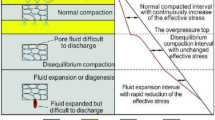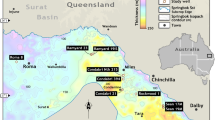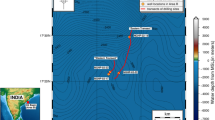Abstract
The purpose of this study is to look into the effects of borehole washouts on log measurements and the resulting error in predicting gas hydrate saturation using well logs. We employ logging while drilling (LWD) data from the Indian National Gas Hydrate Program's second expedition (NGHP-02) in 2015. The NGHP-02 expedition discovered a significant amount of gas hydrate in coarse grain sediments in the Krishna Godavari (KG) Basin while drilling, coring, and logging. Borehole collapse or washout at particular depths in the presence of loose sediments impacted downhole log data at a few sites. We chose Holes NGHP-02-22A and NGHP-02-23A drilled in Area B of the KG Basin for our investigation and attempted to compensate washout effects in density-derived porosity, sonic and resistivity measurements, and the corresponding effects in estimating gas hydrate saturation. We use the sand-shale porosity model to remove the washout effects from density-derived porosity at washed-out depths. The corrected porosities and washout parameters are then used in rock physics theory to remove the washout effects from resistivity and velocity measurements by assuming washed-out zones as vertical fractures filled with seawater. We also estimate gas hydrate saturations from resistivity and velocity logs, taking into account both pore-filling and fracture-filling distributions. Analyzing velocity and resistivity logs jointly, we obtain fracture-filled porosity as 7.5% and 8% at Hole 02-22A and 02-23A respectively. Estimated saturation compared with that of the pressure core measurements show good correlation.













Similar content being viewed by others
References
Archie GE (1942) The electrical resistivity log as an aid in determining some reservoir characteristics. Trans. AIME 146(01): 54–62
Arps JJ (1953) The effect of temperature on the density and electrical resistivity of sodium chloride solutions. Pet Trans. AIME 5(10): 17–20
Boswell R, Myshakin E, Moridis G, Konno Y, Collett TS, Reagan M, Ajayi T, Seol Y (2019) India national gas hydrate program expedition 02 summary of scientific results: numerical simulation of reservoir response to depressurization. Mar Pet Geol 108:154–166
Collett TS, Boswell R, Cochran JR, Kumar P, Lall M, Mazumdar A, Ramana MV, Ramprasad T, Riedel M, Sain K, Sathe AV, Vishwanath K, NGHP Expedition 01 Scientific Party (2014) Geologic implications of gas hydrates in the offshore of India: Results of the National Gas Hydrate Program Expedition 01. Marine and Petroleum Geology 58(A):3–28
Collett TS, Boswell R, Waite WF, Kumar P, Roy SK, Chopra K, Singh SK, Yamada Y, Tenma N, Pohlman J, Zyrianova M, NGHP Expedition 02 Scientific Party (2019) India National Gas Hydrate Program Expedition 02 Summary of Scientific Results: Gas hydrate systems along the eastern continental margin of India. Marine and Petroleum Geology 108:39–142
Collett TS, Riedel M, Cochran JR, Boswell R, Kumar P, Sathe AV (2008) Indian continental margin gas hydrate prospects: results of the Indian national gas hydrate program (NGHP) expedition 01, in: Proceedings of the 6th International Conference on Gas Hydrates (ICGH 2008)
Cook AE, Goldberg D (2008) Extent of gas hydrate filled fracture planes: Implications for in situ methanogenesis and resource potential. Geophys Res Lett. https://doi.org/10.1029/2008GL034587
Cook AE, Anderson BI, Malinverno A, Mrozewski S, Goldberg DS (2010) Electrical anisotropy due to gas hydrate-filled fractures. Geophysics 75:F173–F185
Dai J, Banik N, Gillespie D, Dutta N (2008) Exploration for gas hydrates in the deepwater, Northern Gulf of Mexico: Part II. Model validation by drilling. Mar Pet Geol 25(9):845–859
Dvorkin J, Nur A, Uden R, Taner T (2003) Rock physics of a gas hydrate reservoir. The Leading Edge 22(9):842–847. https://doi.org/10.1190/1.1614153
Dvorkin J, Prasad M, Sakai A, Lavoie D (1999) Elasticity of marine sediments: rock physics modeling. Geophys Res Let 26(12):1781–1784
Ecker C, Dvorkin J, Nur A (1998) Sediments with gas hydrates: internal structure from seismic AVO. Geophysics 63(5):1659–1669
Ghosh R, Ojha M (2021) Amount of gas hydrate estimated from rock physics analysis based on morphology and intrinsic anisotropy in area B, Krishna Godavari offshore basin, expedition NGHP-02. Mar Pet Geol 124:104856
Ghosh R, Sain K, Ojha M (2010) Effective medium modeling of gas hydrate-filled fractures using the sonic log in the Krishna-Godavari basin, offshore eastern India. J Geophys Res Solid Earth. https://doi.org/10.1029/2009JB006711
Helgerud MB, Dvorkin J, Nur A, Sakai A, Collett T (1999) Elastic-wave velocity in marine sediments with gas hydrates: effective medium modeling. Geophys Res Lett 26(13):2021–2024
Hill R (1952) The elastic behaviour of a crystalline aggregate. Proc Phys Soc Am 65:349
Huang T, Zhang Y, Li G, Li X, Chen Z (2020) Numerical modeling for drilling fluid invasion into hydrate-bearing sediments and effects of permeability. J Nat Gas Sci Eng 77:103239
Jakobsen M, Hudson JA, Minshull TA, Singh SC (2000) Elastic properties of hydrate-bearing sediments using effective medium theory. J Geophys Res Solid Earth 105(B1):561–577
Jana S, Ojha M, Sain K (2015) Gas hydrate saturation from heterogeneous model constructed from well log in Krishna-Godavari Basin, Eastern Indian Offshore. Geophys J Int 203:184–194
Jana S, Ojha M, Sain K, Srivastava S (2017) An approach to estimate gas hydrate saturation from 3-D heterogeneous resistivity model: a study from Krishna-Godavari basin, Eastern Indian offshore. Mar Pet Geol 79:99–107
Joshi AK, Sain K, Pandey L (2019) Gas hydrate saturation and reservoir characterization at sites NGHP-02-17 and NGHP-02-19, Krishna Godavari Basin, eastern margin of India. Mar Pet Geol 108:595–608
Kennedy WD, Herrick DC (2004) Conductivity anisotropy in shale-free sandstone. Petrophysics 45:SPWLA-2004-v45n1a3
Koltermann CE, Gorelick SM (1995) Fractional packing model for hydraulic conductivity derived from sediment mixtures. Water Resources Research 31(12):3283–3297. https://doi.org/10.1029/95WR02020
Kvenvolden KA (1988) Methane hydrate—a major reservoir of carbon in the shallow geosphere. Chem Geol 71:41–51
Lee MW (2012) Isotropic, anisotropic, and borehole washout analyses in Gulf of Mexico Gas Hydrate Joint Industry Project Leg II, Alaminos Canyon well 21-A. US Geol Surv Sci Invest Rep 5046:23
Lee MW, Collett TS (2009) Gas hydrate saturations estimated from fractured reservoir at Site NGHP-01-10, Krishna-Godavari Basin, India. J Geophys Res Solid Earth. https://doi.org/10.1029/2008JB006237
Lee MW, Collett TS (2012) Pore-and fracture-filling gas hydrate reservoirs in the Gulf of Mexico gas hydrate joint industry project leg II Green Canyon 955 H well. Mar Pet Geol 34:62–71
Lee MW, Collett TS, Lewis KA (2012) Anisotropic models to account for large borehole washouts to estimate gas hydrate saturations in the Gulf of Mexico Gas Hydrate Joint Industry Project Leg II Alaminos Canyon 21 B well. Mar Pet Geol 34(1):85–95
Lee MW, Hutchinson DR, Collett TS, Dillon WP (1996) Seismic velocities for hydrate-bearing sediments using weighted equation. J Geophys Res Solid Earth 101:20347–20358
Liu T, Liu X, Zhu T (2020) Joint analysis of P-wave velocity and resistivity for morphology identification and quantification of gas hydrate. Mar Pet Geol 112:104036
Makogon YF (2010) Natural gas hydrates—a promising source of energy. J Nat Gas Sci Eng 2(1):49–59
Marion D, Nur A, Yin H, Han DH (1992) Compressional velocity and porosity in sand-clay mixtures. Geophysics 57:554–563
Ojha M, Ghosh R (2021) Assessment of gas hydrate using prestack seismic inversion in the Mahanadi Basin, offshore eastern India. Interpretation 9(2):SD15–SD26
Ojha M, Sain K (2013) Quantification of gas hydrate and free gas in the Andaman offshore from downhole data. Curr Sci 105:512–516
Ojha M, Sen MK, Sain K (2016) Use of split spread configuration of marine multichannel seismic data in full waveform inversion, Krishna-Godavari basin. India J Seism Explor 25(4):359–373
Pandey L, Sain K, Joshi AK (2019) Estimate of gas hydrate saturations in the Krishna-Godavari basin, eastern continental margin of India, results of expedition NGHP-02. Mar Pet Geol 108:581–594
Phillips SC, Johnson JE, Underwood MB, Guo J, Giosan L, Rose K (2014) Long-timescale variation in bulk and clay mineral composition of Indian continental margin sediments in the Bay of Bengal, Arabian Sea, and Andaman Sea. Mar Pet Geol 58:117–138
Pratson LF, Stroujkova A, Herrick D, Boadu F, Malin P (2003) Predicting seismic velocity and other rock properties from clay content only. Geophysics 68(6):1847–1856
Ruppel CD, Kessler JD (2017) The interaction of climate change and methane hydrates. Rev Geophysics 55:126–168
Sain K, Ojha M (2008) Identification and quantification of gas hydrates: a viable source of energy in the 21st century. Mem Geol Soc India 68:273–288
Singh A, Ojha M, Sain K (2020) Predicting lithology using neural networks from downhole data of a gas hydrate reservoir in the Krishna-Godavari basin, eastern Indian offshore. Geophys J Int 220(3):1813–1837
Sloan ED Jr, Koh CA (2007) Clathrate hydrates of natural gases. CRC Press, Florida
Tinivella U (1999) A method for estimating gas hydrate and free gas concentrations in marine sediments. Bollettino Di Geofisica Teorica Ed Applicata 40(1):19–30
Waite WF, Ruppel CD, Collett TS, Schultheiss P, Holland M, Shukla KM, Kumar P (2019) Multi-measurement approach for establishing the base of gas hydrate occurrence in the Krishna-Godavari Basin for sites cored during expedition NGHP-02 in the offshore of India. Mar Pet Geol 108:296–320
Wang X, Sain K, Satyavani N, Wang J, Ojha M, Wu S (2013) Gas hydrates saturation using geostatistical inversion in a fractured reservoir in the Krishna-Godavari basin, offshore eastern India. Mar Pet Geol 45:224–235
Wang Y, Yang Y, Wang K, Tao L, Liu J, Wang C, Yao J, Zhang K, Song W (2020) Changes in relative permeability curves for natural gas hydrate decomposition due to particle migration. J Nat Gas Sci Eng 84:103634
White JE (1965) Seismic waves: radiation, transmission, and attenuation. McGraw-Hill, New York
Yadav US, Shukla KM, Ojha M, Kumar P, Shankar U (2019) Assessment of gas hydrate accumulations using velocities derived from vertical seismic profiles and acoustic log data in Krishna-Godavari Basin, India. Mar Pet Geol 108:551–561
Acknowledgements
We are thankful to the Director, CSIR-NGRI, for providing all facilities to pursue this research work and granting permission to publish this work. The Directorate General Hydrocarbons (DGH) for providing well log data and the Ministry of Earth Sciences (MoES), Delhi, are also acknowledged for research funding.
Funding
This work received support from Council of Scientific and Industrial Research, India, and Ministry of Earth Sciences.
Author information
Authors and Affiliations
Corresponding author
Additional information
Publisher's Note
Springer Nature remains neutral with regard to jurisdictional claims in published maps and institutional affiliations.
Appendix A: Isotropic velocities
Appendix A: Isotropic velocities
Bulk and shear modulus of the sediments using three-phase Biot-type equation (Lee and Collett 2009) are expressed as,
where \(\frac{1}{{K}_{av}}=\frac{({\beta }_{1}-\varphi )}{{k}_{ma}}+\frac{{\varphi }_{w}}{{k}_{w}}+\frac{{\varphi }_{h}}{{k}_{h}}\), \({\beta }_{1}=\frac{{\varphi }_{as}(1+\alpha )}{(1+\alpha {\varphi }_{as})}\), \({\beta }_{2}=\frac{\varphi (1+\gamma \alpha )}{(1+\gamma \alpha \varphi )}\) and \(\gamma =\frac{1+2\alpha }{1+\alpha }.\)
The bulk (\({k}_{ma}\)) and shear modulus (\({\mu }_{ma}\)) of sediment matrix are calculated using Hill’s average equation (Hill 1952). \(\varphi\) is the porosity of the sediment,\({\varphi }_{as}={\varphi }_{w}+\varepsilon {\varphi }_{h}\) is the apparent porosity, \({\varphi }_{h}={S}_{h}\varphi\) is the gas hydrate saturated porosity, \({\varphi }_{w}=\left(1-{S}_{h}\right)\varphi\) is the water-saturated porosity and \({S}_{h}\) is the gas hydrate saturation. The value of \(\varepsilon\) is used here as 0.12. The consolidation parameter \(\alpha ={\alpha }_{o}{({d}_{o}/h)}^{1/3}\), where \({\alpha }_{o}\) is chosen as 65 at Hole NGHP-02-22A and 45 at Hole NGHP-02-23A by calibrating the theoretical velocity of water-saturated sediment with the observed velocity of no gas hydrate zones,\({d}_{o}\) is the maximum depth of investigation below seafloor and \(h\) is the depth below seafloor.
The P-wave velocity (\({V}_{P})\) for the pore-filling gas hydrate distribution is written as,
where \({{\rho }_{b}={\rho }_{s}\left(1-\varphi \right)+{\rho }_{w}\varphi (1-{S}_{h})+{\rho }_{h}\varphi {S}_{h}}\) is the bulk density of sediment, \({\rho }_{s}\) is the matrix density, \({\rho }_{w}\) is the density of water and \({\rho }_{h}\) is the density of gas hydrate (see Table 1).
Rights and permissions
Springer Nature or its licensor holds exclusive rights to this article under a publishing agreement with the author(s) or other rightsholder(s); author self-archiving of the accepted manuscript version of this article is solely governed by the terms of such publishing agreement and applicable law.
About this article
Cite this article
Pandey, L., Ojha, M. Modeling of borehole washout effects and gas hydrate-filled fractures using NGHP-02 downhole data in Krishna Godavari offshore basin, India. Mar Geophys Res 43, 32 (2022). https://doi.org/10.1007/s11001-022-09494-w
Received:
Accepted:
Published:
DOI: https://doi.org/10.1007/s11001-022-09494-w




